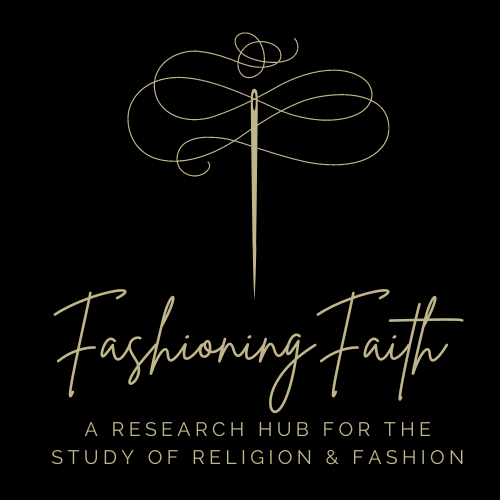Submissions

Join us as we unravel the threads connecting spiritual beliefs and sartorial expression, one stitch at a time.
Thank you for your interest in becoming part of our unique community exploring the fascinating intersection of religion and fashion. Your contribution will help build a valuable resource that illuminates how clothing and accessories express, challenge, and shape religious identity across cultures and time periods. Join a growing network of scholars, designers, and enthusiasts dedicated to understanding how religion and fashion shape one another.
The following guidelines will help ensure your submission stands out while maintaining the scholarly integrity and accessibility that defines our collection.
Quick Links
Contents
We publish scholarly yet accessible entries (1200-1800 words) that explore garments and accessories labeled “religious” through a “cultural diamond” framework. We welcome entries that examine a range of fashion items from handmade to haute couture. Further, we are interested in items that demonstrate the breadth and complexity of the religion/fashion relationship, so anything from popular culture to the church pulpit, from the fashion catwalk to spiritual traditions. Strong submissions should:
1. Entry Document (Word or Google Doc)
- Focus on a specific garment or accessory with religious significance
- Title in “Year + Item Description + Creator” format
- Include cultural diamond analysis (see framework below)
- Use clear, engaging language accessible to both scholars and enthusiasts
- Include proper citations in Chicago Manual of Style (Author-Date)
- Complete reference list
2. Visual Materials
- At least one high-resolution image of the complete item (typically 300 PPI, jpeg)
- Close-up images highlighting important details (when possible)
- Videos of garment being worn or displayed (if applicable)
- All images with proper attribution and permissions (see Rights & Permissions section)
3. Metadata
- 1-2 sentence summary of your entry
- Categories for religion, garment type, time period, and 3-5 additional relevant tags
- Contributor name, affiliation, and date
Your analysis should address at least three of these four interconnected dimensions (Object, Creator, Wearer, and Context). You may present these dimensions in whatever sequence best tells the story of your chosen item (note: in some cases, it may make sense to combine two dimensions):
Object
Explore the garment or accessory itself
- Design elements, materials, construction techniques
- Symbolic features and religious significance
- How physical qualities create meaning (color, texture, shape)
Creator
Uncover the motivations and process behind the item
- Creator’s vision, inspirations, and religious identity
- Relationship between specific garment or accessory the creator’s larger body of work
- Production context and creative decisions
Wearer
Investigate how communities (real or ideal) interpret and use the item
- Embodied experience of wearing the garment
- How different communities adapt or contest meanings
- Gaps between intended meanings and actual reception
Context
Place the item within its broader environment
- Historical moment, fashion trends, religious developments
- Economic, political, or technological influences
- Participation in larger conversations about faith and identity
TIP: Organize your analysis in whatever order tells the most compelling story about your chosen item.
- Prepare Your Materials
- Format entry according to guidelines
- Number images (Figure 1, Figure 2, etc.)
- Submit Your Entry
- Email with subject: “Submission: [Your Entry Title]”
- Send text and image files separately
- Include image placement captions in your text
- Review Process
- Receipt confirmation: 3-5 business days
- Editorial review: 4-6 weeks
- Possible revisions and final preparation
- Image Guidelines
- For your own images: Include “© [Your Name], [Year]”
- For institutional images: Obtain permission and include required credit line
- For Creative Commons: Verify license allows scholarly use and include proper attribution
- For licensed images (e.g. Getty): Purchase appropriate rights before submission
- Entry Terms
- You grant Fashioning Faith non-exclusive publication rights
- You allow minor edits but will review substantial revisions
- You confirm ownership of all content and proper permissions
- You may reuse your research with citation to Fashioning Faith
Complete documentation must accompany all submissions. Questions? Contact Lynn Neal
When analyzing garments with religious significance:
- Obtain proper image permissions
- Respect cultural significance
- Include content notices for sensitive topics
- Consider consulting community members when writing about traditions not your own
- Writing Style: Use clear, jargon-free language with defined specialized terms. Balance academic analysis with vivid descriptions
- Structure: Organize using Cultural Diamond dimensions in your preferred order. Integrate concluding thoughts within the final dimension rather than creating a separate conclusion
- Citations & References: Use Chicago Manual of Style (Author-Date) with page numbers for quotations
- Images: Include descriptive alt text, informative captions, and comparison images when relevant
- Griswold, Wendy. 2013. “Culture and the Cultural Diamond.” In Cultures and Societies in a Changing World, 4th ed. Los Angeles: Sage Publications.
- McDannell, Colleen. 1991. “Interpreting Things: Material Culture Studies and American Religion.” Religion 21: 371–87.
- Prown, Jules David. 1982. “Mind in Matter: An Introduction to Material Culture Theory and Method.” Winterthur Portfolio 17 (1): 1–19.
- Mida, Ingrid and Alexandra Kim. 2024. The Dress Detective: A Practical Guide to Object-Based Research in Fashion. London: Bloomsbury Visual Arts.
- Taylor, Lou. 2002. The Study of Dress History. Manchester: Manchester University Press.
Submissions are evaluated on:
- Scholarly merit (accuracy, depth, originality)
- Framework application (three cultural diamond dimensions)
- Visual documentation (quality, relevance)
- Accessibility (clear writing for diverse audiences)
- Technical requirements (formatting, citations, word count)
Specific feedback will be provided to guide any necessary changes.
Questions? Contact Lynn Neal
Thank you for contributing your expertise to Fashioning Faith!
